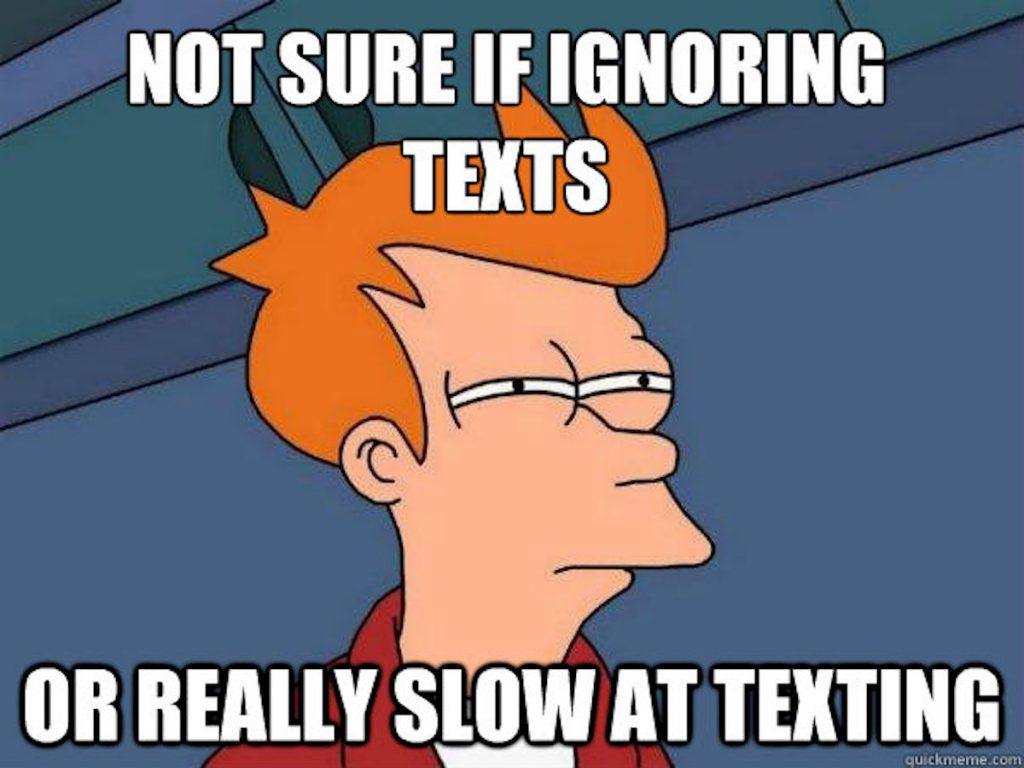To settle down is to sell out, we believe. The result: a plethora of relationship in-betweens that are not quite full-blown romance, not quite courtship, and not quite anything at all. At this point, we don’t even know why we even do this to ourselves; it just happens.
For those who haven’t heard, ‘slow texting’ is just the next in this never-ending line of pseudo-relationship redefinitions that are somehow just so irresistible.

This excludes texters who are genuinely busy, who forgot to reply, and who just abhor the instantaneous-ness texting facilitates. Such people are usually indiscriminate and unintentional slow texters—everyone from their grandmother to their dental receptionist is subject to their non-responsiveness.
Slow texting, the monstrosity that modern dating has birthed, is targeted at individuals whom one might be romantically interested in. It is a consistent, calculated act of delayed response that gives one the upper hand, leaving the person on the other end hanging and wanting more.
While slow texting can occur at any period during courtship, it often surfaces when one is probably just one step away from deciding if they’re finally going to take things seriously.
It is also different from ghosting or simply indicating disinterest, because central to slow texting is the 5 stages of grief. At one point, both parties become willing slow texters, even if they didn’t start out that way.

The longest I’ve waited for a text reply was 120 hours, or five days.
We were still trying to get to know each other and the wait was every bit as agonising and demoralising as you can imagine.
For the first day at least, I managed to convince myself that it was because he’d been swamped with work. That belief became increasingly hard to justify as days passed and the evidence against his ‘busyness’ grew too strong to ignore.
I still vividly recall that sinking feeling upon seeing that he’d managed to share several Facebook posts and upload frequent Instagram stories all the while being ‘too busy’ to reply me.
The final straw came when I saw that he’d replied someone in our shared Whatsapp group chat.
Even as an adult, the rotten feeling of being forgotten and unimportant was one I couldn’t shake off. This feeling, apparently, doesn’t go away no matter how old you are.
Still, I didn’t give up waiting. I couldn’t.
Was I angry that he was making me wait so long? Yes, angry enough in fact that I was determined to stick it out until I received a reply just so I could make him wait for as long as he made me.
When he finally did text, the feeling of seeing my phone light up with his name felt that much sweeter.
Now all I had to do was wait another 120 hours to reply him.
As a male friend rightly put it, “It’s all about the ratio when it comes to slow texting. One is to one. If not you look very desperate.”
While this sounds typical of the start of any relationship, bear in mind: this is not the childish texting tit for tat that eventually blossoms into fuzzy feelings. Little did I know that there would be no end in sight, and that I was to become a willing participant in this pattern of protracted something-but-not-really-anything.

In this day and age of being literally joined at the hip to our phones, slow texting seems entirely counter-intuitive. Why, when given the ‘gift’ of instant connectivity do some people insist on communicating at a snail’s pace?
The answer, according to the Internet at least, is that it’s somewhat grown out of the practice of Benching, a relatively new yet common dating habit.
Benching occurs when you become a reserve for someone keeping their options open. Rather than commit to either dating someone seriously or dumping them, they put you in the mental ‘maybe’ folder. As a result, communication between the two of you swings between hot and cold. The Bencher could disappear from your life suddenly, only to reappear several days/weeks/months later with a string of well-timed Instagram likes and friendly texts.
A common tactic for any Bencher worth his/her salt, slow texting creates just enough of a presence to stay relevant in someone’s life, but not enough such that you actually become involved in said life.
It’s a handy tactic for those who selfishly desire intermittent emotional connection, and someone to just talk to without any of the baggage, accountability and responsibility associated with being in a real relationship. You don’t even have to worry about getting dressed and showing up in real life.
This was a reality that I eventually came to terms with.
I can’t count the number of times I thought to myself, “If only he could come to his senses and see what a good match we’d make. Maybe then he wouldn’t take his own sweet time to reply me.”
At this point, slow texting was his way of having his cake, and eating it too.

On the off-chance that the slow texter decides that he/she wants to take it a step further by either increasing the frequency of the texts or by initiating a meet-up, there remains one last obstacle: inertia.
My colleague, who has been slow texting a guy for several years, shares, “I’m not sure if i’ll ever take the next step. I keep telling myself soon but then I find an excuse to put it off.”
“I’m comfortable with where this is right now,” she adds.
Thanks to slow texting, conversations that could have been done and dusted within a 2 hour time frame are prolonged days, weeks and even months without both parties ever meeting in person. As tedious as this sounds, you eventually learn to be comfortable with such relationship parameters.
What this also means is that these texts will rarely—if ever—amount to anything more than just conversations.
“I think we rarely meet partly because we’re both afraid of something more, i.e. never try, never fail,” says my colleague. “We both know there’s this expectation of something more.”
Not only does meeting up signal a turning point in one’s relationship and commitment, there’s also the risk of shattering the carefully constructed illusion that slow texting creates.
With our slow-texting partners, we often adopt a tone we wouldn’t with our friends—friendly with a hint (or more) of flirty. Never having to sit down with them for a chat over coffee means that we’ll never have to be held accountable for our actions and we’ll never risk being disappointed, or worse, disappointing the other person.
And so, after accepting that a texting relationship is all that we will ever have, it eventually becomes something we want to protect and sustain. It’s predictability becomes a crutch that unlike messy relationships, you know you can count on without having to risk anything.
Over text, we get to present only the best side of our personalities, and believe that this other person truly sees us as we see ourselves.

Despite investing much time and patience cultivating a ‘relationship’ or a ‘friendship’ with your slow texting buddy, you can’t really count on them to be there when you need them. Because this isn’t how this works.
The people you slow text are not the ones you go to for lasting and meaningful connections. Akin to serial dating, slow texting is a perfect fit for the 21st century romantic who thrives on instability, toxic attachments, and commitment phobia.
They’re the ‘4eva alone’ folks whose lives embody the meme, and who won’t admit that it isn’t life that’s hard or other people that suck—they themselves have simply given up.
Perhaps dating apps like Tinder, with their endless choices, have carelessly nurtured a kind of perpetual FOMO and fear of commitment. Or maybe this has something to do how Thought catalog, Tumblr and other pop culture mediums have twisted their idea of what love and relationships should be.
When you slow text, you get to keep believing all of these things, that love is supposed to hurt; that it does not exist, does not last, or does not come easy. This makes the prospect of possible romance far more intoxicating than actually choosing someone to be with, and slow texting is the perfect medium.
It’s little wonder why we’ve become a generation that’s cautious and fickle, yet hungry for connection.
For better or—more likely—for worse, slow texting feeds into this need.






